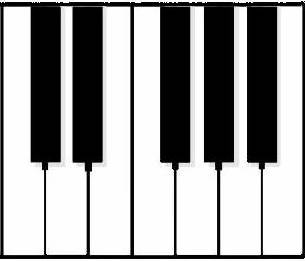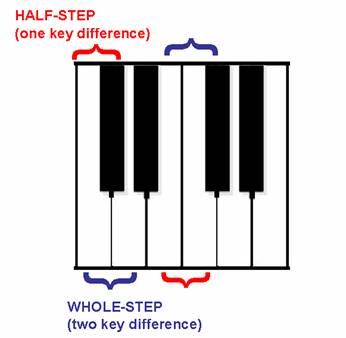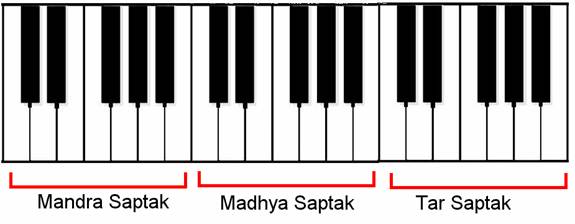Krsna Kirtana Songs
est. 2001 www.kksongs.org
Home
à Music Center à Instrumental Guides à Harmonium Guide
Chapter 05: The Keys of the
Harmonium
We discussed the structure of the harmonium in
Chapter 2. The most essential part of the harmonium is a keyboard. Without the
keyboard no melodies could be played. A harmonium without a keyboard is called
a sruti-peti, or a “sound box.” One note is played
just by pumping a sruti-peti.

Figure 5.1
Look at Figure 5.1. This is a keyboard. Every
harmonium has a different number of keys. The number of keys on the keyboard
describes the range of the
harmonium. A pitch-distance relationship can also be found. Press any key from
the far right end of the harmonium. Compare that sound to any key on the far
left side. You will see that the right side produced a higher pitch while the
left side produced a lower pitch.
A keyboard, in actuality, is a repeating series of a
certain number of keys. This pattern repeats continuously. Let’s take a closer
look.

Figure 5.2
Figure 5.2 shows us the fundamental unit. There are
seven white keys and five black keys. In addition, there is a special
organization of these keys. There are two black keys between the first three
white keys. From the fourth white key to the seventh key, there are three black
keys. This order continues over and over again. This theory will be explain in detail in the next few chapters.
Take a moment and find the starting key of the unit.
From here, press every key in order. Keep in mind that it is
WHITE-BLACK-WHITE-BLACK-WHITE-WHITE, etc… This is the general order.
Once you reached the seventh key, the “eighth” key
is actually the first key in a new pattern. The first key in the second pattern
is eight keys higher than the first key in the first pattern. The pattern of
seven notes is called a scale. Once
the seventh key is completed of the first scale, then the first key starts a
new second scale.
If one were to chose the fourth white key, and go
one full scale higher, then one will reach the fourth white key in the next
scale. The unit of measure of a full scale with eight notes is called an octave. In Western music, the octave is
used because they consider the first key of a new scale to also be the last key
of the old scale. In Indian music, however, the seventh key is considered to be
the last and the first key is considered the start of a new scale. Since we
have seven notes, not eight, our “octave” is properly called a “saptak.” Here
is Figure

Figure 5.3
Obviously, we won’t change saptaks
every moment. We will go within the saptak, at times
go below the saptak, or sometimes go above, or even
do both! To describe the distance, we speak in terms of “steps.” The simplest
form of a step is a “half step.” A
half step is the shortest distance between two notes. For instance, the first
white key and the first black key have a distance of one half-step. Be very
careful! The distances from the third white to the fourth white, as well as the
seventh white to the new first white, are examples of half steps too. There are
no black keys between those two examples. Do not assume that a half step means
distance between the white key and its nearest black key or vice versa!
Two half steps are known as a whole step. For instance, the first white and the second white are
one whole-step apart. Recall from the two exceptions shown above. Look at
figure 5.4 to explain the concept of steps

Figure 5.4 (small sector of the fundamental unit)
Recall how we previously stated that as we go to the
right of the keyboard, the pitches will be high. Conversely, on the left side
of the keyboard, the pitches will be lower. There are three terms that refer to
the relative location of the scale.
The normal pitches and the main scale is known as
the madhya saptak. The
octave above the madhya saptak
is known as the tar saptak.
The octave below the madhya saptak
is known as the mandara saptak.
Figure 5.5 shows a keyboard’s ranges of these three types of saptaks.

Figure 5.5
These facts are really nice to know, especially when
communicating to other musicians musically. However, these facts alone will not
help you define any pitches or keys or melodies. In order to put some sort of
meaning to the notes and keys, we must know the names of the notes and sounds
of the scale. The next chapter will go into the introduction of Indian music.
UPDATED: June 18, 2009
